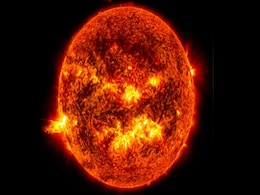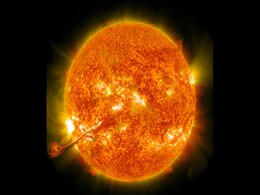Solar Storm 2024
- All
- News
-

May 2024 Solar Storm Triggers Unusual Radiation Belts, Raising Space Safety Concerns
- Wednesday February 12, 2025
- Written by Gadgets 360 Staff
A significant solar storm in May 2024 led to the creation of two temporary radiation belts, detected by the CIRBE satellite in June. One belt contained high-energy electrons, while the other was rich in protons, a rare occurrence. While the electron belt dissipated in three months, the proton-dominated belt remains, potentially affecting space miss...
-
 www.gadgets360.com
www.gadgets360.com
-

AI Could Have Predicted May 2024 Solar Storms, Study Claims
- Sunday February 2, 2025
- Science | Edited by Abhinav Singh
Traditional methods which rely on human analysis of solar images and data, often provide less accurate and timely forecasts.
-
 www.ndtv.com
www.ndtv.com
-

Top 10 Solar Flares of 2024: The Most Powerful Solar Events and Their Impact
- Wednesday December 25, 2024
- Written by Gadgets 360 Staff
The Sun experienced significant solar activity in 2024, with over 50 X-class solar flares recorded. These powerful flares, originating from active regions like AR 13664, were accompanied by coronal mass ejections (CMEs) that caused geomagnetic storms and spectacular auroras across the globe. Among the strongest flares was the X9.0 recorded on Octob...
-
 www.gadgets360.com
www.gadgets360.com
-

NOAA's GOES-19 Satellite Captures First Images of Solar Eruptions
- Friday October 25, 2024
- Written by Gadgets 360 Staff
NOAA's new Compact Coronagraph (CCOR-1), mounted on the GOES-19 satellite, has captured its first images of a solar storm. Launched on June 25, 2024, the satellite provides crucial data on coronal mass ejections (CMEs) from the sun. Unlike ground-based instruments, CCOR-1 offers uninterrupted views of the solar corona, aiding in early warnings of p...
-
 www.gadgets360.com
www.gadgets360.com
-

Solar Maximum Explained: Current Status and Future Expectations in 2024
- Monday October 21, 2024
- Written by Gadgets 360 Staff
Solar maximum is the peak of solar activity in an approximately 11-year cycle. Currently, we are experiencing the solar maximum of Solar Cycle 25, which could last until 2026. This phase is characterized by an increase in sunspots and solar flares, impacting Earth through geomagnetic storms that can disrupt satellites, power grids, and communicatio...
-
 www.gadgets360.com
www.gadgets360.com
-

NASA BioSentinel Investigates Space Radiation During Major Geomagnetic Storm on Earth
- Sunday September 29, 2024
- Written by Gadgets 360 Staff
In May 2024, Earth experienced a magnificent geomagnetic storm, leading to dazzling auroras across the skies. During this event, NASA’s BioSentinel spacecraft collected essential data on solar radiation while orbiting the Sun over 30 million miles away. This research is vital for understanding the effects of radiation in deep space, especially as...
-
 www.gadgets360.com
www.gadgets360.com
-

X-Class Solar Flare Erupts on the Sun, Earth-Directed CME Might Have Been Released
- Sunday September 15, 2024
- Written by Gadgets 360 Staff
A powerful X1.3-class solar flare erupted from the sun on 12 September 2024, potentially boosting aurora visibility across the US this weekend. The flare, which caused a geomagnetic storm rated at G3, also disrupted radio signals in various regions. NOAA’s Space Weather Prediction Center is closely monitoring this solar activity as more flares ar...
-
 www.gadgets360.com
www.gadgets360.com
-

Aurora Season in September 2024 Could Bring Vibrant Northern Lights Due to Earth's Tilt
- Sunday September 8, 2024
- Written by Gadgets 360 Staff
Auroras are expected to be more intense around September's equinox due to the Russell-McPherron Effect. The phenomenon occurs when Earth's magnetic field temporarily aligns with the solar wind, allowing charged particles to penetrate and interact with our atmosphere. This interaction causes vibrant Northern Lights, especially during the equinox. Wi...
-
 www.gadgets360.com
www.gadgets360.com
-

NASA Might Have Spotted Highest Number of Sunspots in Over 20 Years
- Tuesday August 20, 2024
- Gadgets 360 Staff
On August 8, 2024, NASA's Solar Dynamics Observatory (SDO) may have documented a record-breaking number of sunspots in a single day, marking a significant event in Solar Cycle 25. These sunspots, which are dark, cooler areas on the Sun’s surface caused by intense magnetic activity, play a crucial role in the Sun's behaviour and have a direct impa...
-
 www.gadgets360.com
www.gadgets360.com
-

Solar Storm That Recently Hit Earth Was Most Intense Since 2003: ISRO
- Tuesday May 14, 2024
- India News | Press Trust of India
A powerful solar storm impacted Earth in early May 2024, triggered by the highly active region AR13664 in the Sun, ISRO said on Tuesday.
-
 www.ndtv.com
www.ndtv.com
-

Solar Storm: Understanding A Geomagnetic Storm And What To Expect From It
- Saturday May 11, 2024
- Science | Asian News International
A remarkable celestial event is underway as a series of solar flares and coronal mass ejections dazzle the skies, potentially extending the spectacle far across the northern hemisphere.
-
 www.ndtv.com
www.ndtv.com
-

May 2024 Solar Storm Triggers Unusual Radiation Belts, Raising Space Safety Concerns
- Wednesday February 12, 2025
- Written by Gadgets 360 Staff
A significant solar storm in May 2024 led to the creation of two temporary radiation belts, detected by the CIRBE satellite in June. One belt contained high-energy electrons, while the other was rich in protons, a rare occurrence. While the electron belt dissipated in three months, the proton-dominated belt remains, potentially affecting space miss...
-
 www.gadgets360.com
www.gadgets360.com
-

AI Could Have Predicted May 2024 Solar Storms, Study Claims
- Sunday February 2, 2025
- Science | Edited by Abhinav Singh
Traditional methods which rely on human analysis of solar images and data, often provide less accurate and timely forecasts.
-
 www.ndtv.com
www.ndtv.com
-

Top 10 Solar Flares of 2024: The Most Powerful Solar Events and Their Impact
- Wednesday December 25, 2024
- Written by Gadgets 360 Staff
The Sun experienced significant solar activity in 2024, with over 50 X-class solar flares recorded. These powerful flares, originating from active regions like AR 13664, were accompanied by coronal mass ejections (CMEs) that caused geomagnetic storms and spectacular auroras across the globe. Among the strongest flares was the X9.0 recorded on Octob...
-
 www.gadgets360.com
www.gadgets360.com
-

NOAA's GOES-19 Satellite Captures First Images of Solar Eruptions
- Friday October 25, 2024
- Written by Gadgets 360 Staff
NOAA's new Compact Coronagraph (CCOR-1), mounted on the GOES-19 satellite, has captured its first images of a solar storm. Launched on June 25, 2024, the satellite provides crucial data on coronal mass ejections (CMEs) from the sun. Unlike ground-based instruments, CCOR-1 offers uninterrupted views of the solar corona, aiding in early warnings of p...
-
 www.gadgets360.com
www.gadgets360.com
-

Solar Maximum Explained: Current Status and Future Expectations in 2024
- Monday October 21, 2024
- Written by Gadgets 360 Staff
Solar maximum is the peak of solar activity in an approximately 11-year cycle. Currently, we are experiencing the solar maximum of Solar Cycle 25, which could last until 2026. This phase is characterized by an increase in sunspots and solar flares, impacting Earth through geomagnetic storms that can disrupt satellites, power grids, and communicatio...
-
 www.gadgets360.com
www.gadgets360.com
-

NASA BioSentinel Investigates Space Radiation During Major Geomagnetic Storm on Earth
- Sunday September 29, 2024
- Written by Gadgets 360 Staff
In May 2024, Earth experienced a magnificent geomagnetic storm, leading to dazzling auroras across the skies. During this event, NASA’s BioSentinel spacecraft collected essential data on solar radiation while orbiting the Sun over 30 million miles away. This research is vital for understanding the effects of radiation in deep space, especially as...
-
 www.gadgets360.com
www.gadgets360.com
-

X-Class Solar Flare Erupts on the Sun, Earth-Directed CME Might Have Been Released
- Sunday September 15, 2024
- Written by Gadgets 360 Staff
A powerful X1.3-class solar flare erupted from the sun on 12 September 2024, potentially boosting aurora visibility across the US this weekend. The flare, which caused a geomagnetic storm rated at G3, also disrupted radio signals in various regions. NOAA’s Space Weather Prediction Center is closely monitoring this solar activity as more flares ar...
-
 www.gadgets360.com
www.gadgets360.com
-

Aurora Season in September 2024 Could Bring Vibrant Northern Lights Due to Earth's Tilt
- Sunday September 8, 2024
- Written by Gadgets 360 Staff
Auroras are expected to be more intense around September's equinox due to the Russell-McPherron Effect. The phenomenon occurs when Earth's magnetic field temporarily aligns with the solar wind, allowing charged particles to penetrate and interact with our atmosphere. This interaction causes vibrant Northern Lights, especially during the equinox. Wi...
-
 www.gadgets360.com
www.gadgets360.com
-

NASA Might Have Spotted Highest Number of Sunspots in Over 20 Years
- Tuesday August 20, 2024
- Gadgets 360 Staff
On August 8, 2024, NASA's Solar Dynamics Observatory (SDO) may have documented a record-breaking number of sunspots in a single day, marking a significant event in Solar Cycle 25. These sunspots, which are dark, cooler areas on the Sun’s surface caused by intense magnetic activity, play a crucial role in the Sun's behaviour and have a direct impa...
-
 www.gadgets360.com
www.gadgets360.com
-

Solar Storm That Recently Hit Earth Was Most Intense Since 2003: ISRO
- Tuesday May 14, 2024
- India News | Press Trust of India
A powerful solar storm impacted Earth in early May 2024, triggered by the highly active region AR13664 in the Sun, ISRO said on Tuesday.
-
 www.ndtv.com
www.ndtv.com
-

Solar Storm: Understanding A Geomagnetic Storm And What To Expect From It
- Saturday May 11, 2024
- Science | Asian News International
A remarkable celestial event is underway as a series of solar flares and coronal mass ejections dazzle the skies, potentially extending the spectacle far across the northern hemisphere.
-
 www.ndtv.com
www.ndtv.com












